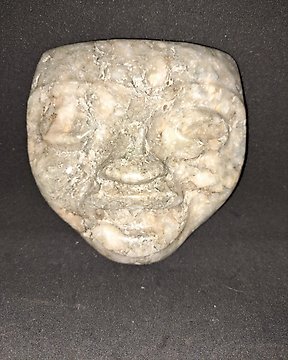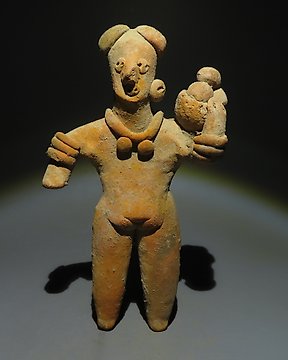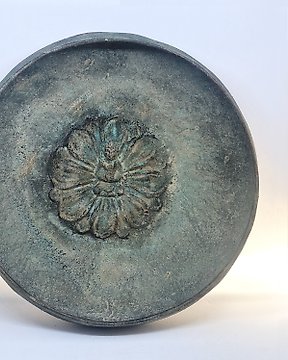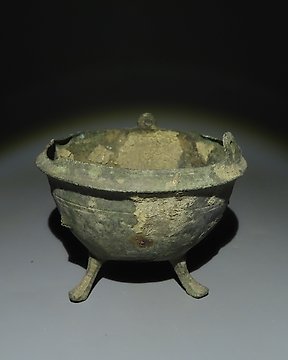Fast shipping perfect packaging the earring is gorgeous !! Everything perfect! Thank you very much
Voir la traductionThank you for the nice feedback, enjoy your beautiful piece!
Catawiki met continuellement à jour ses moyens techniques. La version de navigateur que vous utilisez actuellement est obsolète. Pour avoir la meilleure navigation possible, veuillez mettre à jour votre navigateur.
Vous pouvez définir vos préférences en matière de cookies en utilisant les boutons ci-dessous. Vous pouvez mettre à jour vos préférences, retirer votre consentement à tout moment, et voir une description détaillée des types de cookies que nos partenaires et nous-mêmes utilisons dans notre Politique en matière de cookies .
Nº 85654049



In the realm of ancient artifacts, few pieces carry the mystique of Phoenician art, a culture renowned for its seafaring and trading prowess. This Phoenician bronze statuette, shaped as a goddess from the 6th to the 4th century BCE, stands as a sentinel to the past, a witness to the dawn of civilization in the Mediterranean basin.
An Artistic Interpretation of Divinity
The cruciform shape of this statuette is emblematic of Phoenician religious art, where such figures were common, yet each bears unique characteristics that speak to the individual artist's vision. The elongated and stylized body, coupled with carefully detailed facial features, reflects a culture that valued both form and function in their representations of the divine.
Material and Craftsmanship: A Testimony to Ancient Techniques
Crafted in bronze, a material chosen for its durability and aesthetic appeal, this goddess would have been an object of veneration, perhaps used in personal shrines or for protective purposes. Bronze casting in ancient times was a complex process, indicating that such statuettes were not mere trinkets but rather significant cultural symbols crafted by skilled artisans.
Provenance and Cultural Value
The statuette’s provenance from an Oxfordshire art professional and a British collection formed in the 1980s enhances its allure. The well-documented history of the piece provides a reassuring lineage to collectors seeking artifacts with a clear and traceable background.
Collectible Rarity and Scholarly Interest
As a collectible, this Phoenician statuette is a treasure not only for its rarity but also for its scholarly interest. Comparable pieces are cited in significant publications like "I fenici" (Bompiani, 1988), confirming the type's historical significance. Measuring 114mm x 92mm and weighing 268g, it has a commanding presence, and its state of preservation offers a tangible connection to the Phoenician era.
VISUAL ANALYSIS REPORT:
This Phoenician bronze statuette's cruciform shape and stylized portrayal are characteristic of the period's religious iconography. Notable are the pronounced facial features and the vertical lines on the figure's headdress, which may indicate divine status or attributes. Such figures were often symbolic, possibly representing fertility, protection, or a particular deity's embodiment. The figure's arms are outstretched in a welcoming or offering gesture, which was common in various ancient cultures' votive figures. The combination of this pose with the statuette's overall form suggests that it may have been an object of worship or a votive offering, making it a special item for collectors due to its religious and cultural significance.
PROVENANCE:
Acquired from the esteemed Apollo Galleries in London, UK. Accompanied with Certificate of Authenticity.
In the realm of ancient artifacts, few pieces carry the mystique of Phoenician art, a culture renowned for its seafaring and trading prowess. This Phoenician bronze statuette, shaped as a goddess from the 6th to the 4th century BCE, stands as a sentinel to the past, a witness to the dawn of civilization in the Mediterranean basin.
An Artistic Interpretation of Divinity
The cruciform shape of this statuette is emblematic of Phoenician religious art, where such figures were common, yet each bears unique characteristics that speak to the individual artist's vision. The elongated and stylized body, coupled with carefully detailed facial features, reflects a culture that valued both form and function in their representations of the divine.
Material and Craftsmanship: A Testimony to Ancient Techniques
Crafted in bronze, a material chosen for its durability and aesthetic appeal, this goddess would have been an object of veneration, perhaps used in personal shrines or for protective purposes. Bronze casting in ancient times was a complex process, indicating that such statuettes were not mere trinkets but rather significant cultural symbols crafted by skilled artisans.
Provenance and Cultural Value
The statuette’s provenance from an Oxfordshire art professional and a British collection formed in the 1980s enhances its allure. The well-documented history of the piece provides a reassuring lineage to collectors seeking artifacts with a clear and traceable background.
Collectible Rarity and Scholarly Interest
As a collectible, this Phoenician statuette is a treasure not only for its rarity but also for its scholarly interest. Comparable pieces are cited in significant publications like "I fenici" (Bompiani, 1988), confirming the type's historical significance. Measuring 114mm x 92mm and weighing 268g, it has a commanding presence, and its state of preservation offers a tangible connection to the Phoenician era.
VISUAL ANALYSIS REPORT:
This Phoenician bronze statuette's cruciform shape and stylized portrayal are characteristic of the period's religious iconography. Notable are the pronounced facial features and the vertical lines on the figure's headdress, which may indicate divine status or attributes. Such figures were often symbolic, possibly representing fertility, protection, or a particular deity's embodiment. The figure's arms are outstretched in a welcoming or offering gesture, which was common in various ancient cultures' votive figures. The combination of this pose with the statuette's overall form suggests that it may have been an object of worship or a votive offering, making it a special item for collectors due to its religious and cultural significance.
PROVENANCE:
Acquired from the esteemed Apollo Galleries in London, UK. Accompanied with Certificate of Authenticity.
Fast shipping perfect packaging the earring is gorgeous !! Everything perfect! Thank you very much
Voir la traductionThank you for the nice feedback, enjoy your beautiful piece!
Zeer zorgvuldig verzonden in mooie ringendoosjes. Dank!
Voir la traductionGraag gedaan en veel plezier met deze prachtige ringen!
ottimo servizio arrivato tutto perfetto
Voir la traductiongrazie per la reazione positiva!
Très bel objet. Bien emballé et rapidement livré. Accompagné des documents nécessaires (coa, invoice). Je suis très satisfait et recommande ce vendeur.
Voir la traductionThank you for the positive reply and enjoy this great addition to your collection!
Very Nice . Fast shipping. Thank you.
Voir la traductionYou're welcome and thank you for selecting this fine piece to be part of your collection!
Das ist eine unglaubliche Objekt Ich danke Ihnen vielmals für Verkauf Alles sehr gut gegangen Danke
Voir la traductionVielen Dank für Ihren Kauf und wir wünschen Ihnen viel Glück mit dieser feinen Ergänzung zu Ihrer Sammlung!
Fast shipping perfect packaging the earring is gorgeous !! Everything perfect! Thank you very much
Voir la traductionThank you for the nice feedback, enjoy your beautiful piece!
Le vendeur garantit que l'objet a été obtenu légalement et est en mesure de le prouver. Le vendeur a été informé par Catawiki qu'il devait fournir les documents requis par les dispositions législatives et réglementaires de son pays de résidence. Le vendeur garantit qu’il est autorisé à vendre/exporter cet objet. Le vendeur fournira à l'acheteur toutes les informations connues sur la provenance de l'objet. Le vendeur veillera à ce que tous les permis nécessaires soient (déjà) obtenus. Le vendeur informera immédiatement l'acheteur en cas de retard dans l'obtention de ces permis.
Le vendeur garantit que l'objet a été obtenu légalement et est en mesure de le prouver. Le vendeur a été informé par Catawiki qu'il devait fournir les documents requis par les dispositions législatives et réglementaires de son pays de résidence. Le vendeur garantit qu’il est autorisé à vendre/exporter cet objet. Le vendeur fournira à l'acheteur toutes les informations connues sur la provenance de l'objet. Le vendeur veillera à ce que tous les permis nécessaires soient (déjà) obtenus. Le vendeur informera immédiatement l'acheteur en cas de retard dans l'obtention de ces permis.









